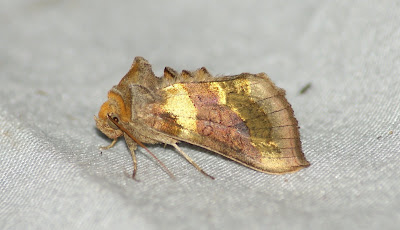Here are some of my favourite moths from last night's moth-trapping session at Ampthill Park. A good crowd turned up, though it had thinned out somewhat by the time we packed up in the early hours. At one point we reckoned that there were a few hundred moths around the main light which was quite a sight. I'll include a list of all the species when it's been published (LIST NOW AT BOTTOM OF POST). One different species that I haven't got a photo of is a Grasshopper Warbler that was reeling in the northern grasslands as we were setting up. It's the first time this year that I've heard this fascinating bird.

This is the Drinker. I'm surprised there's not a pub sign with one of these on...it gets its name from the supposed craving of the caterpillar for dew drops! Hmmm - maybe the Dew Drop Inn in Ampthill ought to have a picture of one of these on the wall!

This is a beautiful moth - the Bordered White. We were running a second trap under some Scots Pine trees, so its presence wasn't a surprise because the larvae feed on the species.

There were several of these Buff Arches moths flying around - I can't wait to get one in my garden trap....

And I wouldn't mind one of these, either: the Peach Blossom. It's not a great photo but I wanted to include it to illustrate the beautiful moths flying around at night that most of us are just not aware of...

...and this one, found late on, has absolutely stunning iridescent colours. It's the Burnished Brass. Wow, who wants to come to the next local moth-trapping session?
84 SPECIES RECORDED:14 Ghost Moth 1
17 Common Swift 2
464 Diamond-back Moth 3
937 Agapeta hamana 2
966 Cochylis atricapitana 3
1032 Aleimma loeflingiana 1
1033 Green Oak Tortrix 1
1175 Epiblema uddmanniana 1
1212 Rhyacionia pinivorana 1
1293 Chrysoteuchia culmella many!
1301 Crambus lathoniellus 2
1302 Crambus perlella 2
1334 Scoparia Ambigualis 1
1392 Udea olivalis 2
1458 Thistle Ermine 2
1509 Stenoptilia pterodactyla 1
1640 The Drinker 1
1648 Pebble Hook-tip 1
1652 Peach Blossom 3
1653 Buff Arches 10
1669 Common Emerald 1
1708 Single-dotted Wave 1
1713 Riband Wave 3
1726 Large Twin-spot Carpet 1
1738 Common Carpet 5
1758 Barred Straw 5
1768 Grey Pine Carpet 1
1840 Shaded Pug 1
1862 Double-striped Pug 1
1893 Tawny-barred Angle 1
1902 Brown Silver-line 2
1931 Peppered Moth 3
1941 Mottled Beauty 4
1950 Brindled White-spot 1
1954 Bordered White 3
1955 Common White Wave 1
1958 Clouded Silver 2
1961 Light Emerald 4
1962 Barred Red 4
1979 Lime Hawk-moth 1
1991 Elephant Hawk-moth 2
2009 Maple Prominent 1
2011 Pale Prominent 1
2047 Scarce Footman 3
2050 Common Footman 1
2088 Heart & Club 1
2089 Heart & Dart 4
2098 The Flame 10
2102 Flame Shoulder 5
2107 Large Yellow Underwing 2
2120 Ingrailed Clay 1
2123 Small Square-spot 5
2128 Double Square-spot 2
2160 Bright-line Brown-eye 2
2193 The Clay 1
2198 Smoky Wainscot 2
2199 Common Wainscot 1
2205 Shoulder-striped Wainscot 10
2250 Dark Brocade 1
2278 Poplar Grey 2
2281 Alder Moth 1
2283 Dark Dagger 1
2284 Grey Dagger 1
2302 Brown Rustic 3
2305 Small Angle-shades 3
2306 Angle Shades 1
2314 Dingy Shears 1
2321 Dark Arches 5
2322 Light Arches 2
2330 Dusky Brocade 1
2331 Small Clouded Brindle 1
2337 Marbled Minor 3
2339 Tawny Marbled Minor 1
2340 Middle-barred Minor 20
2381 The Uncertain 2
2384 Vine's Rustic 2
2387 Mottled Rustic 1
2410 Marbled White Spot 8
2434 Burnished Brass 1
2441 Silver Y 1
2443 Plain Golden Y 1
2474 Straw Dot 5
2477 The Snout 2
2489 Fan-foot 2

